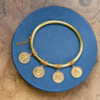This is a very special bracelet that was hand crafted in 18 kt gold in Rome, Italy during the late 19th c. to commemorate a wealthy traveler's Grand Tour on the European continent. The detailed decoration on the body of the bangle, at the junction where each medallion hangs, is in the Etruscan Revival design.
It has four gold medallions which spell out ROMA on one side and AMOR on the reverse. Grand Tour Bracelets with hanging medallions are few and far between.
This bangle is exceptional not only because it is hard to find, but also because it embodies so many aspects of the style at the time. It reflects the desire to travel, learn, and explore which was the heart of the Grand Tour.
It has medallions spelling out ROMA (Rome), a key destination and usually the Grand Finale of the Grand Tour. Lastly, it has hand-crafted fine gold granulation and twisted gold wire work that is the epitome of the Etruscan Revival style made famous by the important Italian jeweler Castellani in his Roman salon and workshops. This kind of detail and workmanship would be costly and hard to reproduce today.
Dimensions & Details
- The bangle is 18 kt gold.
- The inside circumference of the bangle is slightly larger than 6 inches. It would best fit a wrist with a circumference of 6 inches or smaller.
Origin
- Made in Italy. Most likely purchase by a traveler from England, France, or possibly the U.S.
Period & Hallmarks
- Victorian circa 1860/1880.
- Not marked. Acid tested for 18 kt gold.
Condition
- The bracelet is in good antique condition. There are signs of wear and use commensurate with age: fine/light surface scratches. The bracelet opens and closes securely.
More About The Grand Tour/Souvenir Jewelry
The Grand Tour was a traditionally embarked upon by upper-class young men and women, with the goal of rounding out their education. Newly married and older couples also took these long sojourns as well.
The objective of the time abroad was to expand their knowledge of the world by learning new languages and exploring the classical antiquities. Popular stops included Switzerland, Paris, Florence, Venice, and Rome. Rome was most often the Grand Finale of the Grand Tour.
It was an endeavor taken on only by the wealthy, as only the wealthy could afford to travel for months at a time or sometimes several years. Grand tours often turned into continental shopping sprees that resulted in travelers returning with crates filled with books, works of art, artifacts, and jewelry.
Travelers would bring back decor and jewelry in part to demonstrate their taste but, also to preserve the memory of the trip or the experience. Hence the term Souvenir jewelry. Not to be confused with French Souvenir jewelry which also commemorated a memory, but the memory of a loved one, not of a place or an experience.
Even Queen Victoria enjoyed bringing souvenirs back from her travels. She had pebbles from her expeditions and visits polished and set in gold which were then made into brooches and bracelets. Other popular Grand Tour Jewelry included: Cameos, micromosaics, carved coral, and gold pieces in the Archaeological or Etruscan Revival styles.
If you are interested in reading more about the jewelry terms or decorative periods like Etruscan Revival Jewelry, visit our Resources section for additional information.
Find out how to care for your collection of antique and modern jewels: visit our Jewelry Care page to get advice on maintaining and storing your treasured pieces.
Outside of the U.S.? Please contact us for a shipping quote.
Additional Details
- SKU:
- BG560












